Let's Discuss
Enquire NowHi, have you ever thought of us being products and being sold? Weird isn’t it?. Yes, there is a big market outside competing for our attention.
Yeah I know, Most of us have watched the famous documentary, ‘The Social Dilemma’ and have gained some ideas on the topic or some may have thought of it on their own. Also, there might be a few who don’t have a clue. Anyways, what I want to share here are some positive perspectives and the ‘Business Technique’ happening behind the scenes. Let us consider an Interesting scenario of our friend suggesting a product to us. Would it be interesting if we get the same thing as a suggestion when we browse the web?
We can put the above scenario analogous, we may have certain interesting things or products that may differ from person to person. And it’s a clear fact that showing the same ad to every person is not useful in a business scenario, as there are plenty of chances for landing on the wrong person. This problem already has a solution, namely programmatic ad design.
Programmatic ad design uses artificial intelligence in Real-Time Bidding(Explanation later in the section) to automate and streamline the ad buying process. Consider an ad for Kerala mundu, the probability of sales increases by 30% when shown to Keralites of age group between 40-50years. This kind of information can be obtained from various ad campaigns where AI comes into play based on all the data parameters it can have.
Then, what is Real-Time Bidding(RTB)? and where does it happen? and how is it used in programmatic advertising?
RTB tells how a particular ad is shown to us on a particular site and how as a user we are sold in an auction for an impression(or eyesight) to the advertiser. Technically speaking, RTB in advertising is an automated digital auction process that allows advertisers to pay for ad space from publishers(eg: website owner) on a Cost Per Thousand Impressions basis or CPM.
CPM is what an advertiser pays for one thousand people to see the ad. Like an auction, the highest bid for the relevant ad will typically win the ad placement. The RTB process occurs in milliseconds, before the site even loads.
There are mainly three entities in the ad buying cycle :
- Supply Side Platforms(SSPs)
The Platform where the publisher or website owners manage and sell the ad space. It allows the publishers to make the inventory(ad slots) available to programmatic demand. A good SSP should make the inventory available to more buyers.
- Ad Exchanges
It is the platform between the advertiser and the publisher. It is basically like a market of vendors and buyers similar to a stock exchange.
- Demand Side Platforms(DSPs)
It allows the advertiser to buy ad space and manage their ads. DSP is an automated programmatic platform for running, managing and optimizing online ad campaigns. 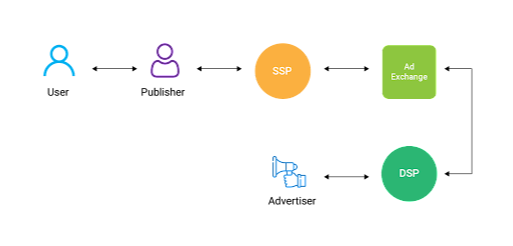
Let us connect all the three:
When we click on a link to move to a site the RTB begins ie, when you arrive at a site before the page loads the publisher sends the ad dimensions and user data like cookies etc from the client-side to the SSPs. Now the SSPs analyse the data based on web activity, interests, demographics etc to determine ‘our kind’ of ads, it also sets a base price for the ad slots.
This information is passed on to the Ad exchange by the SSP. Thereby DSPs get the inventory information from the exchange and assign a value to the user and place a bid on that ad space. The one with the highest bid buys the impression(or eyesight) of that user giving a part of the amount to Ad exchange who acts as the facilitator. Interestingly, it all happens between the time of click and the page gets loaded.
For an easy understanding from an advertising perspective, imagine you want to bid on a car. You hire someone to go to the auction for you, that’s your demand-side platform (DSP). The person putting the car up for auction is the publisher and the venue is the marketplace. Raising your hand to indicate a bid is your real-time bidding process.
These ads are placed programmatically, making them easier to run with a higher return on investment. While RTB isn’t the only type of programmatic advertising that exists, it’s currently the most popular. It’s so popular that by 2021, it’s estimated that RTB algorithms could generate more than $40 billion annually.
We may never think of such a complex business model happening behind us selling our eyeballs to random advertisers. As expressed in the starting, if all these happen in a restricted manner with the knowledge of the user we can assure that it can benefit all the people in the digital ecosystem.
Entities in detail
We can go a little more deeply into these components.
Demand Side Platform(DSP)
Demand Side Platforms helps advertisers to buy the inventories provided by the publishers. It helps them to take part in the auction and bid on users’ ad space.DSPs create, manage and run ad campaigns for the advertiser. The users or the advertisers should be able to add their campaigns and when impressions are received from the exchange or SSPs, then DSP will buy the ad space based on the Region of Interest of the media buyer which is calculated based on the behavioural, contextual and demographic data of the user.
The behavioural data includes the previous sites visited, page views, purchases, ads they have interacted with. This data helps to identify the behaviour of a user. The contextual data comprises the details of the publisher site. And demographic data includes the users’ location, job, gender etc. The contextual data is obtained from the bid request and the behavioural and demographic data are obtained from a third party platform called DMP or the Data Management platform.
DMP stores the data in a collectively organised manner from many platforms from DSPs, SSPs etc to gather insights about customers.

After receiving the bid-request from the ad-exchange, DSPs place bids based on the user-data. The highest bid is selected at the ad-exchange. The winner has to pay the second highest bid price plus $0.01. Every time a user enters a website or refreshes the page the whole process takes place. This takes approximately 100 milliseconds to complete. 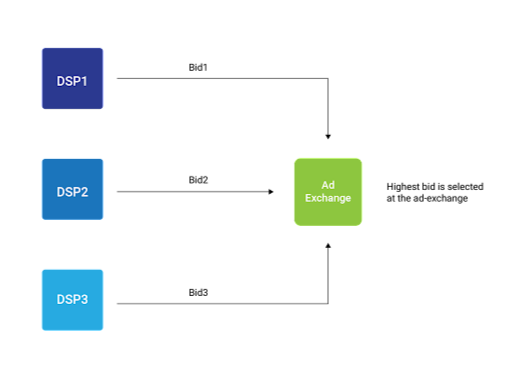
There are two types of DSP platforms available for advertisers namely Self-Service DSP and Full-Service DSP. Self Service DSPs are useful for experienced advertisers as they can take part in the auctions thereon. Full-Service DSPs are used by inexperienced advertisers. Here, the bidding process is completely managed by DSP.
A typical DSP has the following components.
- campaign Manager
- Bidder
- Banker
- User Manager
- ad-server
- Database
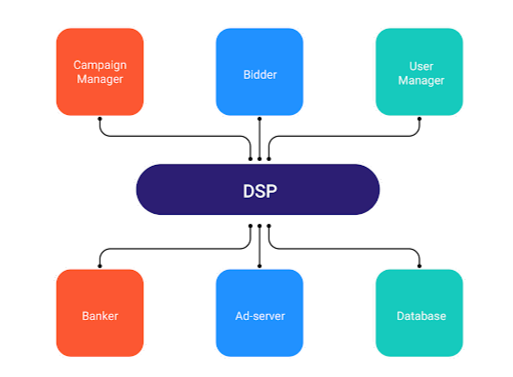
The Campaign manager module monitors the execution of ad campaigns and stores it in the database for managing the ad campaigns by storing the details of ads and helps in determining if a bid request is relevant to any stored campaigns. It monitors the execution of ad campaigns and stores it in the database for tracking the campaigns The bidder module places bids on the bid request in RTB auctions based on some algorithm.
Usually, we keep more than one bidder module to ensure a response within 200ms. The Banker module is responsible for handling the financial data and optimizing the spending. And the user module stores the user data details to get a better user understanding. A DSP may or may not contain an ad serving module. An ad-server stocks the creatives and displays them to the user.
Supply Side Platform(SSP)
The Supply Side Platforms or Seller Side Platforms are used by publishers to manage, optimize and sell the ad spaces in their websites or mobile applications. SSPs should be able to perform all these operations systematically.
The SSPs are configured in three ways; the publisher can sell the ad spaces in Real-Time Bidding auctions. They can sell the high-ticket ad spaces to advertisers directly and they can connect to DSPs directly.
When the publishers’ website is loaded the ad requests are sent to an SSP through an ad server which is then forwarded to ad exchanges or DSPs directly from SSP. Various DSPs place bids on these ad requests and the winning bids are given to the publisher through SSP.

Using SSP, publishers can easily monetize their websites and apps. SSPs are allowed to increase the number of buyers if the value of the bid decreases. They can keep track of all this data and can give insights to publishers about things like which ad-space is having better bid value etc. SSPs also allow the publisher to filter out unwanted ads and the types of ad inventory to be shown on their sites.
Most of the SSP vendors offer two types of platforms: Self-service platforms and full-service platforms. Self-service SSPs are used by experienced publishers. Here the publisher has the privilege of creating, managing and optimizing the inventory. Full-Service SSPs are useful for inexperienced publishers or for ones who don’t want to be involved in this area. In a full-service SSP, the vendor creates, manages and optimizes the inventory. Normally SSPs charge about 0 to 25 percent of the revenue of the publisher. Some of the well known SSPs are Google Ad Manager, OpenX, rubicon etc. A classic SSP has the following components
- Infrastructure
- Ad Trackers
- Ad Exchanges
- Database
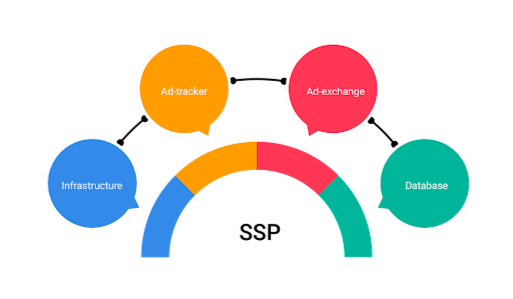
A strong infrastructure is necessary for performing all the required operations in an SSP. SSPs may also provide ad-exchange capabilities which allow them to connect to advertisers through DSP thereby making it easy for the publisher. Ad trackers gather information about the publisher’s website gives insight to the publishers regarding the contents coming into the ad space, its visitors etc
Ad Exchanges
Ad Exchanges are the mediator between the DSPs and SSPs, i.e. between the publishers and advertisers. Ad Exchanges stands between advertiser and publisher or between an ad network and advertisers as a mediator for buying and selling of ad slots in an RTB ecosystem.
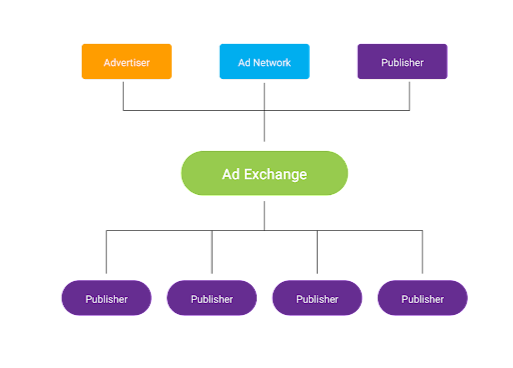
Here bid requests are received from SSPs, and DSPs place bids on this. The winning bid gets the impression. Then the ad-creative is requested by the SSP and the advertiser’s DSP sends the ad-creative to the publisher’s SSP which is finally shown to the user.
The bid should be placed within a fraction of a second else the bid will not be accepted. For google ad exchange this time should be less than 120 milliseconds. Some famous ad-exchanges are DoubleClick ad-exchange, OpenX, Xandr, PubMatic, Facebook ad-exchange.
The whole RTB process takes place every time the user refreshes the browser. This means that trillions of auctions may take place at the same time and ad exchanges should handle this vast number of requests at the same time.
Design
While designing an RTB platform we must keep in mind that we should be able to handle a large number of requests at the same time without throttling. This means that we must select the tech stack considering this fact. Languages like C++, Golang and Java can be used for this purpose. Also choosing the best cloud web services and infrastructure is necessary since there are a wide variety of operations happening behind the scene and to ensure the scalability of the platform. We must also select necessary databases for various storage purposes. In-memory databases like aerospike, Redis etc are used for real-time data access for bidders. SQL or NoSQL databases can be used for normal database operations like keeping ad campaign details, user details etc. Finally, efficient data analytics and solutions can be brought into the picture for efficient bidding and thereby improve the platform.
Our Experience
Here in Dexlock, we have designed a Full-Service Demand Side Platform. We used java in the Dropwizard framework to develop the backend of the architecture comprising Bidder, campaign manager, user manager, and banker modules. Each module worked asynchronously with minimal dependency and connected DynamoDB to store, retrieve and manipulate the BIDs, Campaign-data, and user data with low latency. We followed a rigorous testing phase which helped us understand the shortcomings and thereby minimize all the discrepancies with the platform after integration. Also devising an efficient AI module helped us to improve the Region of Interest in placing the bids by channeling and processing the data asynchronously with various other AWS services.
RTB plays a key role in the future of the advertisement industry. With an efficiently developed RTB platform with machine learning algorithms, advertisers can easily target the required audience. Being a data-centric company, we offer you the best to become part of this digital ecosystem and invite you to build the future with us.
Have a project in mind with similar tech? We can be your best partner. Connect with us here.
Disclaimer: The opinions expressed in this article are those of the author(s) and do not necessarily reflect the positions of Dexlock.



